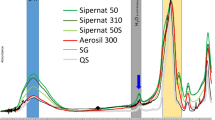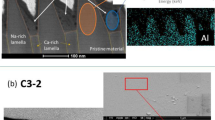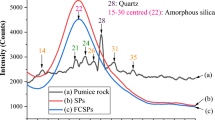Abstract
Adsorption of tetrahedral-forming ions, such as silicates and phosphates, is considered to be the main cause of retention of these anions on the surfaces of hydrated Al- and Fe-oxides. The importance of this retention in natural and man-caused phenomena has been the subject of many investigations. When adsorption studies are conducted, the role of the surface and the charges developed on it by the potentially determining ions tend to be emphasized, while the nature of the sorbate is rarely considered or investigated. Nevertheless, the excluded or equilibrium solution is the seminal source of information in the formulation of adsorption mechanisms or models. The ionic species present in the equilibrium solution are practically always taken for granted, that is, from data previously published. They are thought to be a simple function of solution pH, without further analysis of ionic speciation changes that occur during the sorption process. Here, we provide direct experimental evidence, using an advanced and sensitive spectroscopic technique, laser Raman spectroscopy (LRS), that aqueous equilibrium silicate solutions at low concentrations contain polymeric and/or other anionic complexes and not just monomeric species. These low concentrations are similar to those used in most previous sorption experiments on Fe- and Al-sesquioxides and on tropical acidic soils. Our findings clearly indicate that any mechanisms and models that are proposed to describe anion sorption on sesquioxides should consider that silicates, and probably some other tetrahedral-forming anions, are not present in solution solely as monomeric ionic species as most investigators have assumed1–11. Irregularities in fitting experimental data to models previously reported prompted this research2–4,6,12.
This is a preview of subscription content, access via your institution
Access options
Subscribe to this journal
Receive 51 print issues and online access
$199.00 per year
only $3.90 per issue
Buy this article
- Purchase on Springer Link
- Instant access to full article PDF
Prices may be subject to local taxes which are calculated during checkout
Similar content being viewed by others
References
Obihara, C. H. & Russel, E. W. J. Soil Sci. 23, 105–117 (1972).
Hingston, F. J., Atkinson, R. J., Posner, A. M. & Quirk, J. P. Nature 215, 1459–1461 (1967).
Hingston, F. J., Posner, A. M. & Quirk, J. P. J. Soil Sci. 23, 177–192 (1972).
Goldberg, S. Agron. Abstr. 76, 177 (1984).
Mehlich, A. Chemistry in the Soil Environment (SSSA, 1981).
Parfitt, R. L. Adv. Agron. 30, 1–50 (1978).
Bilinsky, H. & Ingri, N. Acta Chem. Scand. 21, 2503 (1967).
Andersson, K. R., Glasser, L. S. D. & Smith, D. N. in Soluble Silicates (ed. Falcone, J. S.) 115–131 (American Chemical Society, Washington DC, 1981).
Falcone, J. R. Jr. in Soluble Silicates (ed. Falcone, J. S.) 134–148 (American Chemical Society, Washington DC, 1981).
Stumm, W. & Morgan, J. J. Aquatic Chemistry (Wiley, New York, 1970).
Schleger, W. L. & Blumberg, J. G. in Soluble Silicates (ed. Falcone, J. S.) 49–69 (American Chemical Society, Washington DC, 1981).
Bowden, J. W., Posner, A. M. & Quirk, J. P. Soils with Variable Charge (New Zealand Society of Soil Science, 1980).
Fortnum, D. & Edwards, J. O. Inorg. Nucl. Sci. 5, 264–265 (1956).
Freund, E. Bull. Soc. Chim. Fr. VII 8, 2244–2249 (1973).
Freund, E. Bull. Soc. Chim. Fr. VII 8, 2239–2243 (1973).
Bass, J. L. in Soluble Silicates (ed. Falcone, J. S.) 17–28 (American Chemical Society, Washington DC, 1981).
Lazarev, A. N. Vibrational Spectra and Structure of Silicates (Transi, from Russian Archard, G. D.; Transi, ed. Farmer, V. C. (Consultants Bureau, New York, 1972).
Tarte, P. Etude Experimentale et Interpretation Des Spectre Infra-rouge des Silicates et des Germantes (Palais des Academies, Bruxelles, 1965).
Beard, W. C. Adv. Chem. Ser. 121, 162–168 (1973).
Marinangeli, A., Morelli, M. A., Simoni, R. & Bertoluzza, B. Can. J. Spectrosc. 22, 173 (1978).
Eitel, W. Silicate Science Vol. 5, 41–49 (Academic, New York, 1965).
Alvarez, R. thesis, Univ. Hawaii (1975).
Iler, R. K. J. Colloid. Interface Sci. 53, 476–482 (1975).
Iler, R. K. The Chemistry of Silica (Wiley, New York, 1979).
Gimblett, F. G. R. Inorganic Polymer Chemistry (Butterworth, London, 1963).
Greenberg, S. A. & Sinclair, D. J. J. phys. Chem. 59, 435–440 (1959).
Shimono, T., Isobe, T. & Tarutani, T. J. Chromatogr. 258, 73–80 (1983).
Roller, P. S. & Ervin, G. E. J. Am. chem. Soc. 72, 464–471 (1940).
Author information
Authors and Affiliations
Rights and permissions
About this article
Cite this article
Alvarez, R., Sparks, D. Polymerization of silicate anions in solutions at low concentrations. Nature 318, 649–651 (1985). https://doi.org/10.1038/318649a0
Received:
Accepted:
Issue Date:
DOI: https://doi.org/10.1038/318649a0
This article is cited by
-
Vibrational spectra and dissociation of aqueous Na2SiO3 solutions
Catalysis Letters (2007)
Comments
By submitting a comment you agree to abide by our Terms and Community Guidelines. If you find something abusive or that does not comply with our terms or guidelines please flag it as inappropriate.



